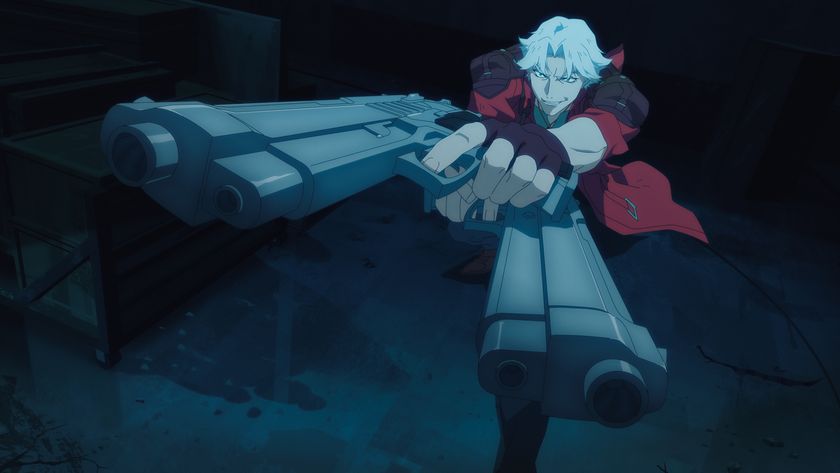The Torchwood and Life On Mars author writes for SFX.co.uk about the joys and challenges of penning a steampunk western...
Today we welcome writer Guy Adams to the site. He's already an established author but he's begun a new series for Solaris, called The Heaven's Gate Chronicles, which are described as "Weird Westerns". The first novel is The Good, The Bad And The Infernal and we invited Adams to write for us on this subject: "Why does steampunk provide such an interesting sandpit for an author to play in?"
Photo below © Peter Coleborn

I feel like Richard E Grant as Withnail, who once went on holiday by mistake. Not for me the damp, terrible splendour of a Welsh holiday cottage, poachers and predatory uncles rather the thick smog and coal stacks of a genre that is new to me.
I've written a steampunk novel by mistake.
This is not an unusual position for me, I'm a great believer in running at a book with mad abandon, who can be surprised if it becomes something I didn't altogether expect? It certainly could be worse, I could be here talking about my new Goat Porn trilogy and that would be awkward for all of us.

The Good, The Bad And The Infernal , the first in a trilogy published by Solaris Books, started off life as a western. Arguably it ended its life as one too, the toes of its leather boots pointing up into wide Arizona skies, but it gathered other trappings along the way.
Sign up to the SFX Newsletter
Get sneak previews, exclusive competitions and details of special events each month!
The only difficulty I have with the situation is that in press interviews for the book I keep being asked about the steampunk genre. This is natural enough, I've just written a novel featuring land locomotives and Native American tribes gene-spliced with steam engines. I can't deny this spade is a spade when the long handle is jutting up for all to see. Still, being one of those silly authors who thinks about things too deeply, I now feel like something of a cheat discussing a genre I've only recently dipped a toe into. It is not a genre in which I am well read. Asking my expert opinion on it is rather like asking Nicholas Sparks to discuss military sci-fi.
That said, if there's one thing authors do with gusto it's make stuff up and feign authority. So, when I was asked to write this guest blog answering the question "Why does steampunk provide such an interesting sandpit for an author to play in?" I did what I always do, say yes and worry about the details later. Which is now. Sigh...
I can certainly say why it was interesting for me. I am not a writer well-versed in restraint. While The Good, The Bad And The Infernal does its very best to be historically accurate up to a point, I am not a writer that enjoys letting reality hold him back. This is why the last few years have seen me write novels about infinite houses where you can go sailing in the bathroom; nightclubs run by the living dead; espionage departments dealing with supernatural terrorism and, well, a western that centres on a doorway to the afterlife. If you're going to make things up, say I, then you might as well be hanged for a dragon as an iguana.
I'm a great believer in cooking stews of novels. I like a lot of different flavours. The dry, sand-blasted, chilli-infused tang of the western; the hot, salty copper of horror; the bourbon and tobacco of pulp crime; the banana-split and anchovy of comedy. They're all worth chopping up and throwing into a book whenever the recipe allows.
A flavour I use time and again is Victoriana. I've served my time with Sherlock Holmes (having written two original novels plus a Persian slipper full of non-fiction), and The World House featured an explorer from the late nineteenth century as one of its central characters. That world of port wine, dark cobbles and antimacassars is very dear to me. Victoriana is my garlic, I throw that bugger in whenever the stew will allow.
Historical fiction, though, as I believe Shakespeare once said, can be a bit of an arse. It brings with it a whole new portmanteau of rules and pitfalls. Simply: you have to get your facts right. We get away with mistakes all the time of course, because most readers don't know the minutiae of history any better than we do (I'm reminded of a scene in Anthony Horowitz's excellent Holmes novel The House Of Silk where the detective lights his cigarette off a gasogene, a clever trick given that it's actually a type of soda siphon). Still, we all try to avoid such things. In steampunk this is less of an issue, all the flavour of the Victorian era but with a built-in liberty when it comes to historical, or scientific fact. That's the thing with alternate universes, you can do what you like with them, Simon Schama won't have a leg to stand on if he decides to pick a fight. For any type of fantasist that's incredibly appealing.
(I will just note that, at least so far, The Good, The Bad And The Infernal is set in our world rather than any alternate universe, because I'm not only a bad planner but I'm also stupid).
But steampunk is also all about the aesthetic. I can't think of many literary genres that come with a dress code.
Steampunk is full of flavour... the burning of coke, the texture of velvet, the hiss and punch of hydraulic systems. It's not only a literary genre it's a shared sensibility that any of us can imagine. And for those of us who secretly dreamed of being Victorian gentlemen but never had the piercings or foreign policies to quite pull it off, steampunk allows us a chance to dabble. To enjoy the trappings but play the most important writing game of all: 'what if?'
"Why does steampunk provide such an interesting sandpit for an author to play in?" Because the sandpit is deep and filled with treasure. You can dig for years and still find something new.
But don't ask me, I don't even work here full time. Though, having enjoyed the experience I wouldn't be surprised if I applied for a few more shifts.
Thanks Guy! You can get the book from Amazon.co.uk or Amazon.com and there's an extract ready to read now on the Solaris editors' blog. Find out more about Guy Adams at his website or on the Solaris website .
SFX Magazine is the world's number one sci-fi, fantasy, and horror magazine published by Future PLC. Established in 1995, SFX Magazine prides itself on writing for its fans, welcoming geeks, collectors, and aficionados into its readership for over 25 years. Covering films, TV shows, books, comics, games, merch, and more, SFX Magazine is published every month. If you love it, chances are we do too and you'll find it in SFX.













